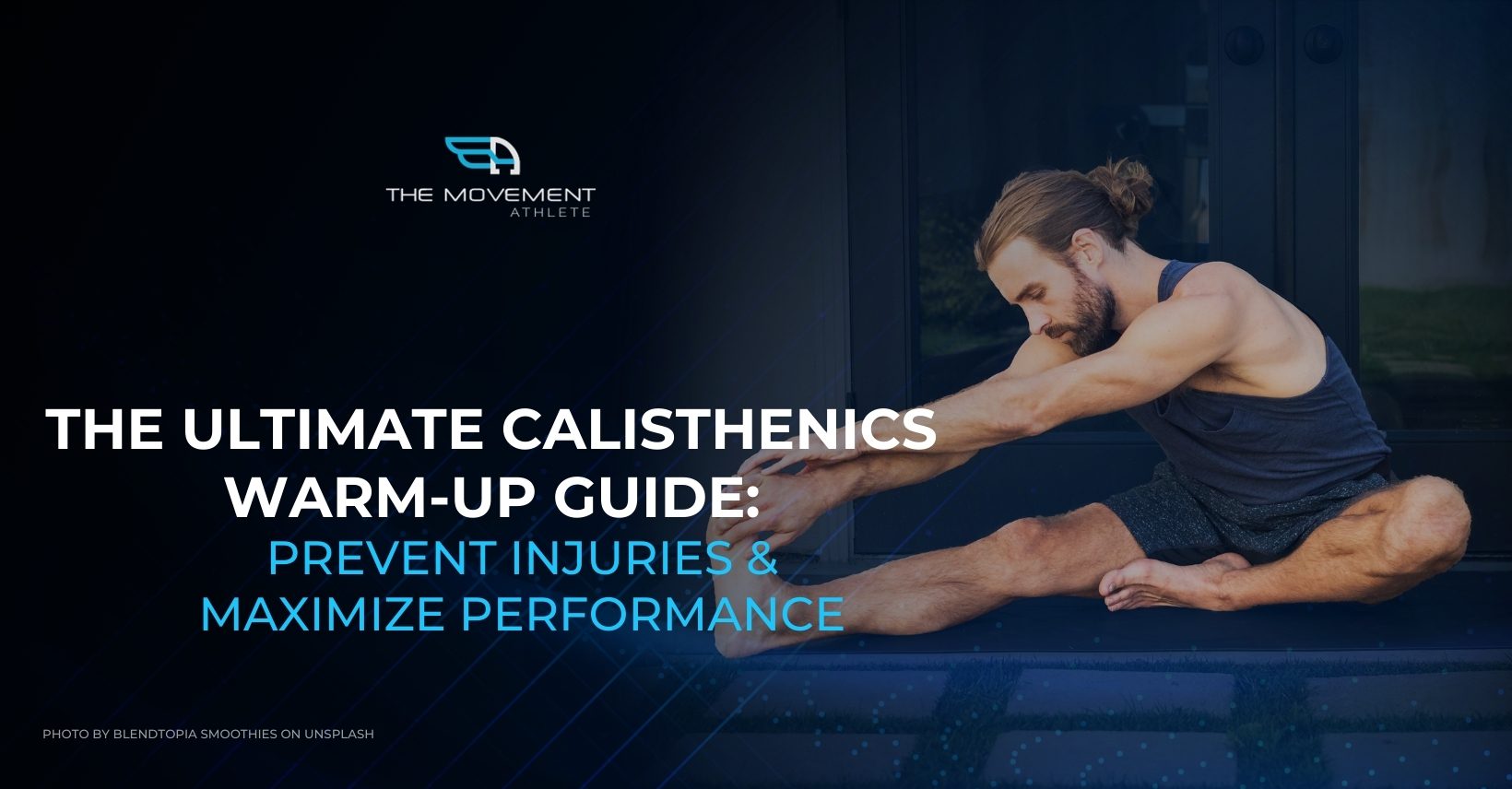
Join the tribe of Movement & Calisthenics Athletes – people just like you that are working with their own body weight to get strength, lose fat build muscle, recover from injuries and live their best lives!
🤔Do you want to perform better in your workouts?
🤔Do you want to prevent injuries?
If so, then check out the ultimate calisthenics warm-up guide!☝️
This article contains a step-by-step process on how to get warmed up for any workout of your choice.
🔎What is a warm-up?
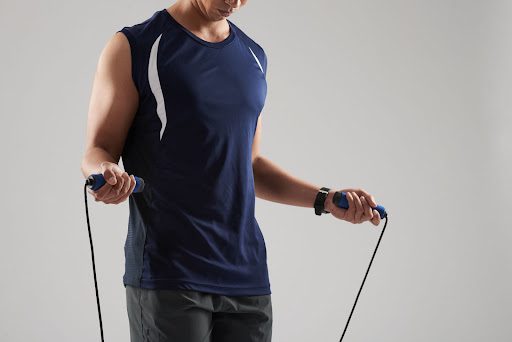
Jump rope is a good cardiovascular exercise and can also be used as a warm-up to raise your body temp. Photo from Freepik
Calisthenics warm-up exercises are movements that help prepare the body for the main workout. This is done primarily for injury prevention and to maximize training performance by increasing your heart rate, getting the blood flowing, and increasing the range of motion for your workout.
🏆Benefits of warm-up
We often focus our full attention on our primary workout that we tend to do half-ass warm-ups. This shouldn’t be the case.
Warm-ups offer a number of benefits that can help you improve your performance and prevent injuries.
Here are just some of the benefits you’ll see from warming up:
✅Better Mobility
You get a better range of motion for your movements, which will allow for more successful reps to avoid unnecessary straining muscles during workouts.
Mobility vs flexibility
✅Enhanced Training Performance
Muscles become stronger when they’re warm because there’s an increase in blood flow to them and their fibers lengthen out so it becomes easier to engage them later on. This means less risk for injury too because your body doesn’t get surprised with the upcoming workload.
✅Better mentally
Aside from the physiological preparation that enhances your training, warmups also prime your mind so you can divert all your focus towards your workout. The more focused you are, the better your performance is.
✅Better muscle activation
Calisthenics training is primarily built on compound movements. With the right warm-up, you enhance the control for the key muscles that will be used in your workout. This is critical for optimum performance, and it’s especially crucial when it comes to practice sessions.
✅Prevent injuries
Adding those we mentioned above, calisthenics warm-ups prepare our bodies so that we can avoid muscle pulls, joint pains, and other injuries. This is the reason our warm-up routine has to be comprehensive, though not exhaustive.
✊ The truth behind static stretching
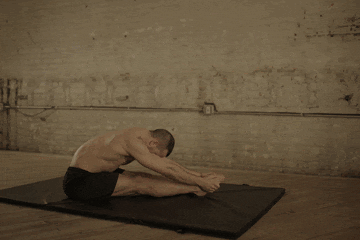
A deep pike stretch is better done at the end of your workout.
We often hear that you need to stretch for warming up your muscles.
Okay, we have to bust one major myth surrounding any warm-ups: AVOID static stretches in your warm-ups. Those are exercises where you hold a specific position where the muscles are at their end range with the help of an external force (the floor, gravity, a friend, or yourself). Refer to the photo above as an example.
Static stretching isn’t bad if you place them at the cooldown phase of your workout. Placing them at the beginning will actually increase the risk of injury by as much as 30%.
Why?
Recent studies show that static stretching prior to a workout decreases muscle strength and muscle performance. This decrease can lead to a higher risk of injury.
Instead, do dynamic stretches which do the opposite: promotes better performance and muscle activation by increasing blood flow instead of “relaxing” the muscle lengthening it due to the static stretches.
Static stretches are better at the end of your workout as you cool down and relax from your workout.
With this in mind, let’s look at a comprehensive routine for calisthenics athletes to prevent injuries and improve performance:
TAKE NOTE: If any soreness or pain occurs, stop and get yourself checked out physically by a professional.
🤜Warm-up Routine based on calisthenics workout
We’ll categorize our warm-up exercises per body part so that we can implement them accordingly to our calisthenics workouts.
Each exercise has a specific goal but many exercises here caters to multiple goals and multiple body parts at the same time.
Here are the main goals these warm-up exercises assist in:
- increase mobility
- help muscle activation
- increase body temperature
⚡️Upper body warm-up
🎯Shoulders
Many upper bodyweight exercises demand some form of shoulder mobility. From pull-up, push-up, dips, all in different progressions, they require you to be able to do a certain range of motion with control.
These two exercises fit perfectly to the mix of warm-up routines in order to mobilize your shoulder joints for maximum performance.
Shoulder dislocates
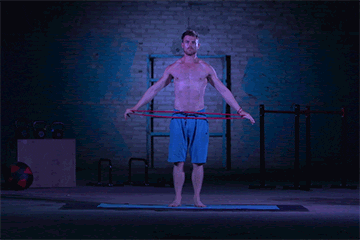
This exercise prepares the shoulders for extension, flexion, and upward rotation, and downward rotation.
Don’t worry. There’s no actual dislocation involved in the exercise.
With this, you’ll need a stick or a set of resistance bands.
Begin holding the stick or resistance band at both ends in front of you with straight arms. From here, lifting your arms overhead while maintaining a straight back. Continue the movement to the back then reverse the pattern.
Do this for 10 reps.
Adjust the intensity of the exercise by moving your grip width. The wider, the easier, the narrower, the harder.
Shoulder rotations
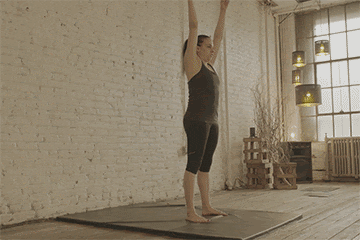
You can also do the opposite rotation for each arm for additional coordination training.
This movement is simple, easy, yet very effective at warming up your shoulder joints for your upper body training.
Extend your arms straight and make circles with your arms. Keep your elbows locked out and keep the circles wide.
Do 10 reps of clockwise and anti-clockwise.
Make sure you’re doing controlled movements with your arms and not just flailing them around.
🎯Upper torso
Thoracic spine mobility is crucial for proper posture and overall spine health. It’s also vital for body alignment which is integral in many calisthenics exercises especially handstands and planches.
Cat camel
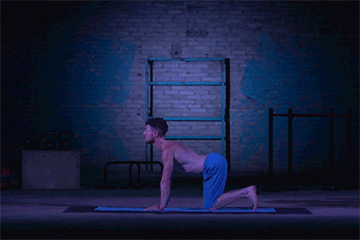
With the interesting name, cat camel is even more interesting as it helps promote thoracic spine mobility that’s easy to progress from beginner level to advanced.
Not only that, but it also helps in scapula activation for that scapula protraction and scapula depression required in our bodyweight fundamentals.
Begin in a quadruped position. Tilt your hips forward. Breath then crunch your back into a ball and push your shoulders away from your ears. Move your head down. Hold it for a brief moment. Then slowly exhale as you pinch your shoulder blades together and look back up with your head. Hold it for a brief moment and repeat the movement pattern for the exercise.
Aim for 10 reps.
🎯Wrists
The wrists are surely getting a lot of action in upper-body training. It’s also a small joint compared to the larger shoulder and hip joints which is why a proper warm-up is a must.
Wrist rocks
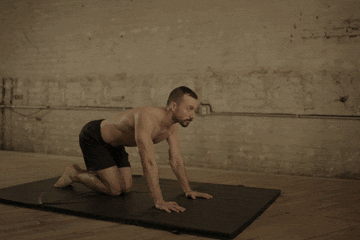
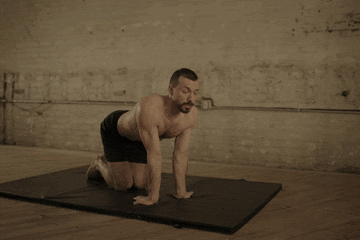
Most of the calisthenics exercises such as pull-ups, dips, and pull-ups play around flexion and extension of the wrists. Rock backward and forward are simple yet effective wrist preparation.
Focus on leaning forward and backward as far as you can. This shouldn’t be painful so just “stretch” the wrists as far as your mobility permits you.
Wrist rotations
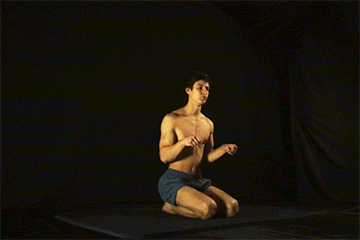
Aside from flexion and extension, it’s also best to prep wrist rotations for overall mobile wrists.
To do this, simple to wrist circles clockwise and counterclockwise. You can do 10-20 reps for each direction.
🎯Scapula
In calisthenics (and in general fitness workouts), Scapula training is very much underrated. The scapula or also referred to as the shoulder blades play an important role in shoulder joint stabilization and health.
It is connected to multiple upper body muscle groups which are why strengthening and mobilizing the scapula promotes better movement for many calisthenics exercises such as push-up and pull-ups.
There are four main movements you need to focus on:
- Protraction – pull apart your shoulders
- Retraction – pinch shoulders together
- Elevation – push your shoulders upwards towards your ears
- Depression – push the shoulders downwards away from your ears
- Inward rotation – overhead arm movement
- Downward rotation – moving your arms down
Scapula push-ups
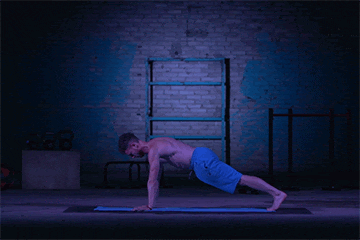
Scap push is a vital calisthenics warm-up exercise. You shouldn’t begin your training without it for your push days.
Scapula protraction is used for exercises such as planche. Imagine pulling your shoulder blades apart.
For the exercise, begin in a push-up position. Imagine pushing down further the ground and pulling apart your shoulder.
Take note that you need to keep your back muscles in a straight neutral position. Elbows locked out. Also, keep your shoulders depressed at all times.
From there, slowly pinch them back together and that’s one rep. This is the retraction.
For beginners, you can begin in an inclined position or on your knees.
Do 5 to 10 reps.
Scapula pulls
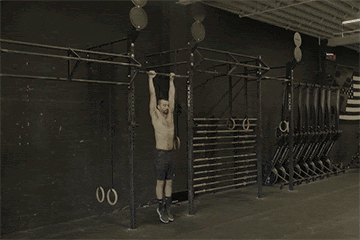
If you want stronger pull-ups, you’ve got to do this exercise.
Scapula pulls train the scapula retraction and elevation and depression.
Begin by hanging on a bar. Pull retract your scapula and depress your shoulders while keeping everything engaged.
Slowly release to get back to the natural position. Repeat for reps.
For beginners who find it too difficult to begin in a dead hang, you can opt for a diagonal hang with feet planted on the ground similar to the beginning position of a bodyweight row.
Do 5 to 10 reps.
⚡️Lower body warm-up
Now let’s talk about warming up the lower body. We’ll be focusing on the legs, ankles, and hips.
Not only these exercises will prepare you for your workout, they will also improve your overall mobility for better movement and quality of life.
🎯Ankles
Knee to wall
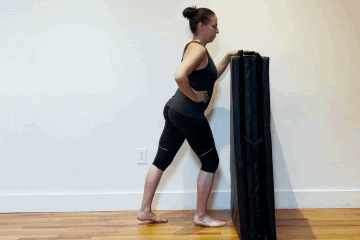
Similar to wrists, your ankles need some love and care which we usually neglect to provide since it’s a very used joint in general movement patterns such as walking and running. But those motions aren’t enough if you want to break through a plateau and want to improve your mobility and avoid injuries.
This motion is quite similar to wrists rocks but working on one ankle at a time.
Stand in front of a wall. Step one foot back and one foot near the wall. Rock your knee slowly back and forth towards the wall to mobilize the ankles.
The farther your closer foot to the wall is, the more you get from the stretch making the exercise easy to scale for beginners and advanced.
Interestingly, you can also feel your calves stretching which is perfect for warm-up.
Do 10-20 reps of the rocking motion for each leg.
🎯Glutes/hamstrings
The next two exercises work the posterior chain of the legs, particularly the glutes and hamstrings.
Deep squat
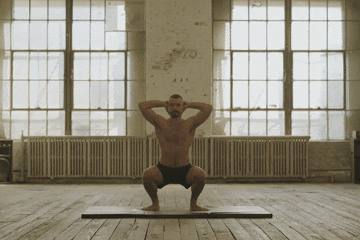
This is such a great stretch for the muscles and the ankles.
To perform, begin by standing with good posture then lower down to the deep squat while keeping the upper torso vertical or slightly diagonal. Chest out and back straight.
A beginner might find this move difficult at first, but you can train towards this goal by using a form of assistance. Just hold on to anything sturdy as you move to the deep squat.
You can also place a low elevation to sit on to limit the range of motion while you are working on that “stretching” and mobility component.
This warm-up is perfect for bodyweight squats.
Hold for 30 – 60 seconds. You can also play with the weight distribution in different directions as you hold the deep squat.
Glute bridge
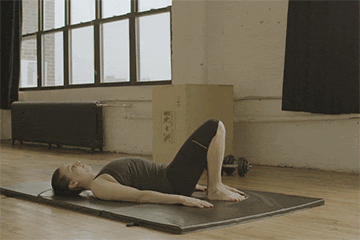
Another move for the posterior chain AND lower back is the glute bridge.
Begin by lying on the floor with bent knees and feet firmly planted on the ground. Hands by your side. Push your hips upward while engaging your core. Keep your back straight and don’t let it arch. Focus on using your legs and hips to perform the motion.
Hold for 15 to 30 seconds.
🎯Hips
The hips play a major role in many leg movements. Immobile hips can hinder your leg mobility and even lead to other injuries in your lower back and posture.
Keep them moving and warmed up in your routines.
Fire hydrant
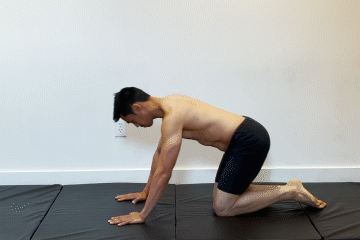
The fire hydrant looks simple and easy yet very difficult to perform when you’re first starting out.
Begin in a quadruped position. Lift one leg backward by contracting the glutes. Keep your hips squared. Then move your leg sidewards until on the side. Repeat this for reps and for the other side. Also the other way around.
Keep your core engaged and your pelvis tilted forward.
Do 5 to 10 reps for each leg for each direction.
You can take videos of yourself to assess the form.
⚡️Entire body warm-up
For warming up the whole body, just do both upper and lower calisthenics warm-up exercises then you are good to go.
Include these routines for your calisthenics and other discipline training.
🎯 Incorporating cardio
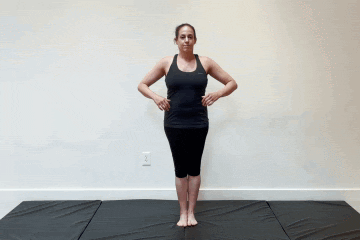
Warming up with short cardio is a great way to increase your heart rate and get the blood pumping.
Just include a short 1 to 5-minute cardio. Jogging and jumping jacks are good choices. Of course, you’re not limited to these options. Just keep it light depending on your skill level and you can also mix it up throughout the routines.
Remember that you have a different goal in your workout. If your main goal is endurance, that’s the time you have to put longer periods for this type of warm-up.
🎯Specific warm-up
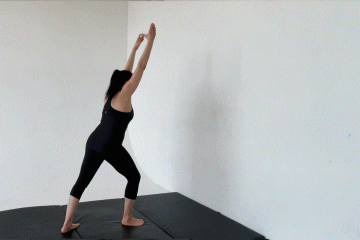
You can use ,for example, this kick up exercise before training for your main freestanding handstand just to get you prepped for your kick ups.
For calisthenics training, warming up could be further improved by implementing actions that mimic the exercises included in the main workout.
These exercises work by priming the target muscles for the upcoming workout load.
Here are just a few examples but aren’t limited to them.
- plank
- dead bug
- handstand
- incline push-ups
- light resistance band rows
As a general guide, 🤔 think of your main workout then choose the easier variations for warming up.
For example, if you’re going to train push-ups, incline push-ups can work.
If you’re advanced and training with one-arm push-ups, normal push-ups can work as well.
Just keep the reps minimal and not tiring. 10-15 reps is a good range as long as you don’t fatigue at the end rep.
There’s no limitation to the exercise you can choose as long as it’s not inducing fatigue and easy enough for your current skill level.
🧐How many reps and set?
As mentioned above, 10 reps or a 30-second hold is a good benchmark.
The focus of the warm-up is to warm up, not tire you out before the actual workout.
👊To wrap it up
Warm-ups are essential in protecting your joints and muscles while letting them maximize the potential for your workout performance.
Keep it light and non-exhaustive, but don’t breeze through it like it’s nothing.
Commit to each movement and you will feel the benefits of the warm-up in your workout session.
If you feel like there’s too much to process regarding warm-ups, head over to The Movement Athlete so we can prepare the warm-up for you.
Let us know what you think of the guide so we can further improve it if anything’s missing.
We want to hear you in the comment section down below! 😀
Train smart!💪💪